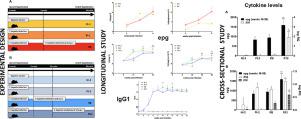当前位置:
X-MOL 学术
›
Acta Trop.
›
论文详情
Our official English website, www.x-mol.net, welcomes your
feedback! (Note: you will need to create a separate account there.)
Impact of fascioliasis reinfection on Fasciola hepatica egg shedding: relationship with the immune-regulatory response.
Acta Tropica ( IF 2.1 ) Pub Date : 2020-05-01 , DOI: 10.1016/j.actatropica.2020.105518 M Adela Valero 1 , Nuria Gironès 2 , Marta Reguera-Gomez 1 , Ignacio Pérez-Crespo 1 , M Pilar López-García 3 , Carla Quesada 1 , M Dolores Bargues 1 , Manuel Fresno 2 , Santiago Mas-Coma 1
Acta Tropica ( IF 2.1 ) Pub Date : 2020-05-01 , DOI: 10.1016/j.actatropica.2020.105518 M Adela Valero 1 , Nuria Gironès 2 , Marta Reguera-Gomez 1 , Ignacio Pérez-Crespo 1 , M Pilar López-García 3 , Carla Quesada 1 , M Dolores Bargues 1 , Manuel Fresno 2 , Santiago Mas-Coma 1
Affiliation

|
Fascioliasis is a disease caused by liver flukes. In human fascioliasis hyperendemic areas, reinfection and chronicity are the norm. Control strategies in humans require the use of egg count techniques to calculate the appropriate treatment dose for colic risk prevention. The present study investigates how fascioliasis reinfection affects liver fluke egg shedding and its relationship with the immune-regulatory response. The experimental design reproduced the usual reinfection/chronicity conditions in human fascioliasis endemic areas and included Fasciola hepatica primo-infected Wistar rats (PI) and rats reinfected at 4 weeks (R4), 8 weeks (R8), 12 weeks (R12), and negative control rats. In a longitudinal study (0-20 weeks post-infection, p.i.), serical IgG1 levels and eggs per gram of faeces (epg) were analyzed. In a cross-sectional study, the expression of the genes associated with Th1 (Ifng, Il12a, Il12b, Nos2), Th2 (Il4, Arg1), Treg (Foxp3, Il10, Tgfb, Ebi3), and Th17 (Il17) in the spleen and thymus was analyzed. In R8 and R12, transiently higher averages of epg and epg/worm in reinfected groups vs PI group were detected at least in the weeks following reinfection. The kinetics of IgG1 levels shows that reinfected groups followed a pattern similar to the one in the PI group, but transiently higher averages of IgG1 levels in reinfected groups vs the PI group were detected in the weeks following reinfection. Epg correlated with IgG1 levels and also with systemic Il10 and thymic Ifng, and Il10 expression levels. These results suggest that epg depends on the Th1 and Treg phenotype and that the determination of the fluke burden by epg is likely to be an overestimation in cases of recent reinfection in low burden situations. A strategy to facilitate the implementation of epg count techniques and the subsequent decision on the appropriate treatment dose for each patient to prevent colic risk is required.
中文翻译:

筋膜病再感染对肝片筋膜排卵的影响:与免疫调节反应的关系。
筋膜病是由肝吸虫引起的疾病。在人类筋膜炎高发区,再感染和慢性病是常态。人类的控制策略要求使用卵数计算技术来计算适当的治疗剂量,以预防绞痛风险。本研究调查了筋膜炎再感染如何影响肝吸虫卵脱落及其与免疫调节反应的关系。实验设计重现了人类筋膜炎流行地区的常见再感染/慢性病条件,包括肝炎片状Fasciola primo感染的Wistar大鼠(PI)和分别在4周(R4),8周(R8),12周(R12)和阴性对照大鼠。在一项纵向研究中(感染后0-20周,pi),分析了每克粪便(epg)的血清IgG1水平和卵。在横断面研究中 分析与Th1(Ifng,Il12a,Il12b,Nos2),Th2(Il4,Arg1),Treg(Foxp3,Il10,Tgfb,Ebi3)和Th17(Il17)相关的基因在脾脏和胸腺中的表达。在R8和R12中,至少在再感染后的几周内,与PI组相比,再感染组的epg和epg /蠕虫的平均瞬时升高。IgG1水平的动力学表明,再感染组的模式与PI组相似,但在再感染后的几周内,与PI组相比,再感染组中IgG1水平的瞬时平均值更高。Epg与IgG1水平以及全身性Il10和胸腺Ifng和Il10表达水平相关。这些结果表明,epg依赖于Th1和Treg表型,并且在近期在低负荷情况下再次感染的情况下,通过epg确定吸虫负担可能被高估了。需要一种策略来促进实施epg计数技术,并为每个患者制定适当的治疗剂量,以防止发生绞痛风险。
更新日期:2020-05-03
中文翻译:

筋膜病再感染对肝片筋膜排卵的影响:与免疫调节反应的关系。
筋膜病是由肝吸虫引起的疾病。在人类筋膜炎高发区,再感染和慢性病是常态。人类的控制策略要求使用卵数计算技术来计算适当的治疗剂量,以预防绞痛风险。本研究调查了筋膜炎再感染如何影响肝吸虫卵脱落及其与免疫调节反应的关系。实验设计重现了人类筋膜炎流行地区的常见再感染/慢性病条件,包括肝炎片状Fasciola primo感染的Wistar大鼠(PI)和分别在4周(R4),8周(R8),12周(R12)和阴性对照大鼠。在一项纵向研究中(感染后0-20周,pi),分析了每克粪便(epg)的血清IgG1水平和卵。在横断面研究中 分析与Th1(Ifng,Il12a,Il12b,Nos2),Th2(Il4,Arg1),Treg(Foxp3,Il10,Tgfb,Ebi3)和Th17(Il17)相关的基因在脾脏和胸腺中的表达。在R8和R12中,至少在再感染后的几周内,与PI组相比,再感染组的epg和epg /蠕虫的平均瞬时升高。IgG1水平的动力学表明,再感染组的模式与PI组相似,但在再感染后的几周内,与PI组相比,再感染组中IgG1水平的瞬时平均值更高。Epg与IgG1水平以及全身性Il10和胸腺Ifng和Il10表达水平相关。这些结果表明,epg依赖于Th1和Treg表型,并且在近期在低负荷情况下再次感染的情况下,通过epg确定吸虫负担可能被高估了。需要一种策略来促进实施epg计数技术,并为每个患者制定适当的治疗剂量,以防止发生绞痛风险。









































 京公网安备 11010802027423号
京公网安备 11010802027423号